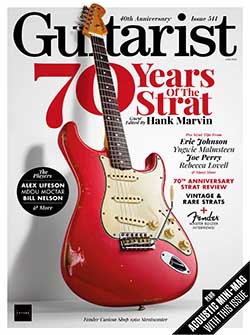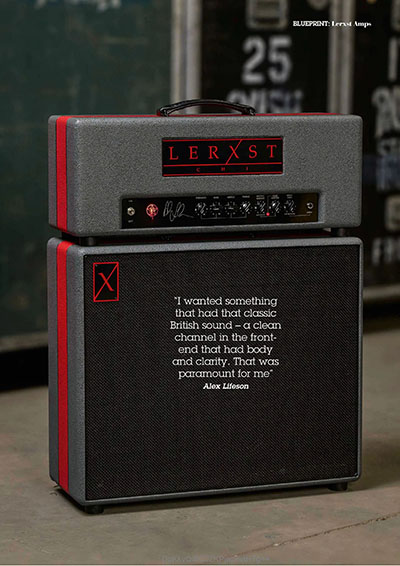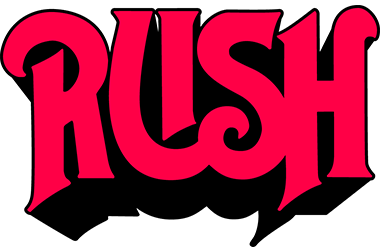
|
Guitarist Magazine June 2024 Issue #511 Words: Charlie Wilkins Photography: Richard Sibbald |
hand-built in the USA, that offer up his acclaimed tone to the masses.

 Nearly a decade after the band’s farewell tour, Rush’s music continues to resonate with millions. But for guitarist Alex Lifeson, the journey doesn’t end there. With a flourishing side project called Envy Of None, and Lerxst - an amplifier, guitar and pedal line launched in partnership with Mojotone of Burgaw, North Carolina — Lifeson shows no signs of slowing down. We sit down with the legendary musician and Mojotone CEO Michael McWhorter to discuss their collaboration and creative process on the Lerxst amplifiers, along with Lifeson’s enduring love for the craft and what the future holds for one of rock’s most iconic figures.
Nearly a decade after the band’s farewell tour, Rush’s music continues to resonate with millions. But for guitarist Alex Lifeson, the journey doesn’t end there. With a flourishing side project called Envy Of None, and Lerxst - an amplifier, guitar and pedal line launched in partnership with Mojotone of Burgaw, North Carolina — Lifeson shows no signs of slowing down. We sit down with the legendary musician and Mojotone CEO Michael McWhorter to discuss their collaboration and creative process on the Lerxst amplifiers, along with Lifeson’s enduring love for the craft and what the future holds for one of rock’s most iconic figures.
Alex, how did the Lerxst brand get started and how did you develop a partnership with Mojotone to build the amps?
Alex Lifeson: “My recollection is that Geddy [Lee]’s tech had already been working with Mojotone on pickups and accessories. When we recorded the Clockwork Angels album [released in 2012] I used a Marshall Silver Jubilee. I really liked it and I used it for a lot of the record. After we finished recording, I thought, ‘I gotta find one of these, but there were very few out there and no-one wanted to sell. So l approached Michael for help with finding one and he said that Mojotone could build whatever I wanted. I said, ‘That’s awesome!’ I felt that the Jubilee would be a great platform and starting point to build from but maybe soften the top-end a little bit and round out the mids. So they built the amp and I used it for all the consecutive Rush tours.”
Michael, tell us about the creative process.
 Michael McWhorter: “I was a die-hard Rush fan since sixth grade so when Alex asked, ‘Hey, can you do this?’, the answer was immediately, ‘Of course!’ This is without talking to any of my build crew first [laughs]. When Alex made suggestions, like ‘more mids’ or ‘more mid-sweep control’, or some other subtle things, everyone on our crew, who are also all die-hard Rush fans, were eager to jump on it. It was an easy process working with Alex, and I thoroughly enjoyed it all the way through.” Alex: “The Omega and Chi models have been around for several years, but we decided on a cosmetic change that looks really sexy to me. They look very elegant and really stand out compared with a lot of other amps out there - more traditional and not super wild. Michael also has some ideas to do hand-wired versions. Now we've come to a point, all these years later, where we're looking at a whole group of new products to run in the Lerxst line. I’m really proud of the amps. From the very beginning, I didn’t want to stick my name on something just to sell more. These amps are really what I wanted them to be.”
Michael McWhorter: “I was a die-hard Rush fan since sixth grade so when Alex asked, ‘Hey, can you do this?’, the answer was immediately, ‘Of course!’ This is without talking to any of my build crew first [laughs]. When Alex made suggestions, like ‘more mids’ or ‘more mid-sweep control’, or some other subtle things, everyone on our crew, who are also all die-hard Rush fans, were eager to jump on it. It was an easy process working with Alex, and I thoroughly enjoyed it all the way through.” Alex: “The Omega and Chi models have been around for several years, but we decided on a cosmetic change that looks really sexy to me. They look very elegant and really stand out compared with a lot of other amps out there - more traditional and not super wild. Michael also has some ideas to do hand-wired versions. Now we've come to a point, all these years later, where we're looking at a whole group of new products to run in the Lerxst line. I’m really proud of the amps. From the very beginning, I didn’t want to stick my name on something just to sell more. These amps are really what I wanted them to be.”
Talk us through the spec and features of the Lerxst amps.
Michael: “The Omega is a 50-watt head that runs on a pair of EL34s, is switchable down to 25 watts, and has two channels with a Master Volume and Effects Loops. It’s British voiced with a unique LED gain stage that Marshall kind of introduced back in the 80s. It really gives amore direct, pointed, distortion sound.
“The Chi is a 30-watt combo with a similar gain structure, but it’s not just an ‘Omega Junior’. It runs on a pair of 6L6s, which are obviously different from EL34s, so it has a different kind of headroom. You can really hear all six strings when you play a big Alex Lifeson chord. Even with the gain all the way up, all six strings are very defined. Both amps sound similar, but the lower-wattage Chi is really its own thing. It’s a cousin, rather than a child.”
Alex, do you use both models?
Alex: “Yeah, I have an Omega right here and a Chi just right around the corner. I used the Chi on a gig not too long ago with Andy Kim. He does a Christmas show here in Toronto every year, so I’ve been doing that gig for about 12 years. They normally supply an amp for me, but this time around I took the Chi and it sounded great. I’m an old man now, but it was easy to carry around.
“I'll also echo Michael’s response about the Chi: you hit a chord and you hear everything. With some amps, depending on how you’re pushing the mids, the top-end gets a little wonky or a little invisible, but the Chi is equal all the way through. I was really impressed because it was the first time I used it in a live situation. It was a really good experience for me to actually get it out and use it in that environment.”
 Michael: “The first Chi design we sent to Alex had 6V6s. He liked it but asked if we could make it sound more open. 6L6s seemed to be the obvious route to give it more headroom and make it brighter and more open. There’s really nothing like a 6L6 to open things up.”
Michael: “The first Chi design we sent to Alex had 6V6s. He liked it but asked if we could make it sound more open. 6L6s seemed to be the obvious route to give it more headroom and make it brighter and more open. There’s really nothing like a 6L6 to open things up.”
How did the development process work between yourself, Alex, and Mojotone?
Alex: “With everything that we work on, Michael will send me something - whether it’s an amp or pedal, or whatever it is — and I'll live with it for a period of time and try to use it in many different environments or situations to get a pretty comprehensive take on what’s happening. Then I would usually send it back and give my comments. Then the next iteration would arrive and I would do the same thing until we finally had it nailed.”
Tell us more about the power scaling feature on the amps.
Michael:“It’s a switch that brings the 50 watts down to 25 watts and lets you go from stage to bedroom. You don’t really lose much going down to 25 watts. Alex, I think with your live rig, you were playing the Omega at 25 watts, right?”
Alex: “Yes, I was. I think if you have the levels set in the right place, it gives you all of that, you know, at a lower volume. It is a little spongier, not compressed, but very limited in a way. But when you crank it up, you can still get all that dimension and it may come very close to having the full wattage characteristics.”
And you also have matching cabinets.
Michael: “Yeah, we have an oversized 4x12 cabinet for the Omega that’s pretty fun. It’s loaded with Mojotone BV-25M speakers. There’s also a 2x12 cabinet loaded with the BV-25s. The Chi comes in a head and a combo [format]. We’re using a 12-inch Mojotone Greyhound in the combo, which is a 70-watt speaker and a really good pairing. I can’t remember how many different speaker combinations and variations we went through and landed on that one. Not just because it was a Mojotone speaker, but because we thought it sounded the best. Ultimately, Alex had the final vote, of course.”
Alex: “They sent me tons of cabinets and I went through them all. I have to say that the tall 4x12 cabinet sounds fantastic. Last year when we did the Taylor Hawkins tribute, Dave Grohl and Omar Hakim came up from Los Angeles to rehearse with Geddy and me for a couple days. So I had that cabinet and my Omega and I was just blown away by how awesome it sounded.
 “With Rush, because of the staging requirements, we didn’t have cabinets on stage. We had props, reflecting that period in the tour so I used a Palmer speaker simulator, mostly. I liked it because it gave me consistency: night after night, it sounded exactly the same. It’s so variable with a mic in front of a speaker cabinet, depending on humidity, temperature, all of those things can affect it. The Palmers gave me exactly the same sound all the time.
“With Rush, because of the staging requirements, we didn’t have cabinets on stage. We had props, reflecting that period in the tour so I used a Palmer speaker simulator, mostly. I liked it because it gave me consistency: night after night, it sounded exactly the same. It’s so variable with a mic in front of a speaker cabinet, depending on humidity, temperature, all of those things can affect it. The Palmers gave me exactly the same sound all the time.
As Brad [Madix], our front-of-house guy, got to know my sound and expectations, my sound just got better and better because he had that consistency to work with. So it was a treat for me to actually hear that cabinet in more of a live situation.
“Here in my studio, I have an isolation cabinet with a single 12-inch speaker that I run all my different amps through and it sounds brilliant. I’m so totally sold on the difference between plug-ins and a mic in front of a speaker. Plug-ins are great because they’re so convenient and there are so many variables — you can have a lot of fun creating things. But they sound like, you know, it’s pasted on your monitor screen. As soon as you get a 57 or 421 in front of a 12-inch speaker, boy... Now you hear dimension, you hear the sizzle on the outside. It is such a big difference. Why would you ever use a plug-in? Other than it’s quick and easy if you’re doing a demo or something.”
When you guys were in development, did you consider a design that would cater to both classic and modern tones?
Alex: “I don’t know what ‘modern tone’ means exactly. My requirement was that I wanted something that had that classic British sound. I basically wanted a clean channel in the front-end that had body and clarity. That was paramount for me because my experience with a lot of amps has been that the clean end was never quite the way I heard it in my head. It tended to be a little skinny and just not warm. It’s really down to those two channels: a dirty and a clean. Then you can manipulate whatever you want with your effects or whatever. You can shape it in a myriad of ways, but the basic foundation has to be body and clarity.
“On the dirty side, I wanted something crunchy, but if I rolled it off a little bit on the guitar I can get clarity in the rhythm playing, then pull it up and give that little boost for soloing with sustain and creaminess. It sounds kind of simple and trite, but my requirements were very, very basic and we accomplished that”
Alex, have you moved away from rack-mounted gear? What does your rig look like now?
 Alex: “Well, it’s certainly not what it was when we were touring. I think I’ve gone back to more of a traditionalist approach with a short cable into the front-end of the amp. I’ve really come to appreciate that, after using radios [wireless] for so many years just out of necessity and convenience. Cable makes such a big difference in the way the guitar is speaking to the amp; you feel more connected. I use some pedals, but generally I like to record everything direct and then add plug-ins or whatever. If I’m doing a live gig, I’ll take a delay pedal and maybe a chorus.
Alex: “Well, it’s certainly not what it was when we were touring. I think I’ve gone back to more of a traditionalist approach with a short cable into the front-end of the amp. I’ve really come to appreciate that, after using radios [wireless] for so many years just out of necessity and convenience. Cable makes such a big difference in the way the guitar is speaking to the amp; you feel more connected. I use some pedals, but generally I like to record everything direct and then add plug-ins or whatever. If I’m doing a live gig, I’ll take a delay pedal and maybe a chorus.
“I had such an addiction to chorus that I’m trying to avoid it as much as I can. It started with the Roland JC-120 on A Farewell To Kings. In the studio when we were finished recording, I would just sit in front of that amp, maybe had a little puff of something, and just play in front of this beautiful shifting Stereo Chorus that was mind blowing. That’s when my addiction started and it was a little overwhelming. I used chorus on everything for most of the 80s.”
The chorus really shaped your tone and it sounds great.
Alex: “Yeah, Andy Summers would not complain [laughs].”
Did you use the JC-120s on stage?
Alex: “No, as soon as the first chorus unit came out, it was the CE-1 - the big one. That’s what I used and I still have it. It’s 48 years old or something and it still works and sounds amazing.”
 Alex, your tone has evolved so much over the years with Rush, and then with side projects like Envy Of None where you're going in a completely different direction. Do the Lerxst amps cover all the sonic ground that you need when you play live?
Alex, your tone has evolved so much over the years with Rush, and then with side projects like Envy Of None where you're going in a completely different direction. Do the Lerxst amps cover all the sonic ground that you need when you play live?
Alex: “I’m not playing live much any more, but I did use the Omega on the last couple Rush tours. I’m probably using my Omega for the new Envy Of None material, more than anything else. I’m comfortable with it and I know what to expect. The Envy Of None stuff is some of my favourite guitar playing. Maybe it’s because it’s so current. Maybe it’s because it’s so freeing. For me, it’s liberating. Because I mean, very few solos. I don’t know if there are any solos to speak of, so it’s a whole different approach. It’s not Rush and I love it.
“Because of that fact, I got to explore other things. I learned how to make my guitar sound so unlike a guitar. That was a really cool challenge and such a creative endeavour for me. This material for the second album is definitely Envy Of None and you can’t miss it because of Maiah [Wynne’s, vocalist] voice, but the material is awesome. It sounds so good. It’s really going to be great.
“So yeah, I have my go-to gear in the studio and I like to work fast. I can’t sit still and I'm always on the move. I’m very impulsive and everything happens really quick in the studio. I think I get bored. Geddy is the complete opposite. He’s very methodical. He has to try everything before he knows what doesn’t work. Whereas when I’m working on my solos, after those first five or six takes, I lose interest. It drives me crazy, but at the same time, that’s the best that’s gonna come out of me. That’s been my observation of my playing and the way I work, whether I like it or not.”
When you get to that point, do you just tell Geddy or your producer that you're done?
Alex: “It’s interesting because to give you an example, with Moving Pictures, typically I would go in and do five or six takes of the solo and then I feel like I’m getting a little stale and Geddy would say, ‘That’s fine, leave it with us, so he and Terry Brown [producer] would comp solos. [had to leave and was not allowed to stay in the room, which was fine. It takes a lot of energy out of you, when you're that intensely focused on playing. So I would come back and if it sounded great and not too ridiculous, I would approve it and we would move on. If not, then we just attack it again.
“What I liked about that was that it involved everybody in the band. Everyone has a stake in it and you’re not just focused on your own individual, selfish space. You're working together in the service of the song and to make it the best it can be. You can impart all your different influences and thoughts. It was a great working environment, despite us all being quite different as songwriters.”

https://lerxstamps.com
-| Click HERE for more Rush Biographies and Articles |-

